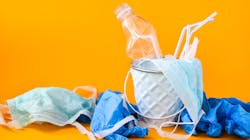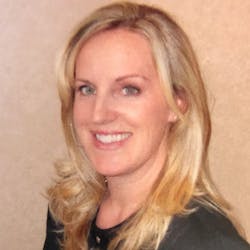A pulmonologist, an ob-gyn, and a surgeon walk into a dental office: The effect of increased PPE on the oral health of medical workers
Working across the street from a major university hospital, about half of my patients are health-care workers. My office is an established boutique practice that has steadily operated under the same dentist for 40 years. The patient base consists of loyal, longtime patients who refer new patients. Patients come here for honest, conservative dentistry and the playful wit of their dentist. Pre-COVID-19, I was averaging about 11 patients a day, three days a week, so I saw about 15 health-care workers per week. Then the pandemic hit, and all the dental offices closed.
Fast forward 10 weeks and we reopened. New protocols, PPE, and adjusted schedules went into effect. I started seeing patients again, but eight a day instead of 11, and about 12 per week were health-care workers. Overall, patients were happy to be in the dental office. I was hearing things like: “I am so happy to be here!” and “I am so glad I got the text!” There is always that small percentage who love getting their teeth cleaned, but this was happiness across the board. After thinking about it, it does make sense. These health-care providers who had been battling so hard for humanity the last three grueling months were finally getting care.
Noticing a trend?
One patient I saw is a pulmonologist. She told me the last three months have been the hardest in her life, but for now, things have slowed down enough for her to catch up on some self-care. Her chief complaint was that her night guard had split and she was having cold sensitivity on her lower right side. The dentist diagnosed that she had a fracture on number 30 and needed a crown and a new night guard.
The next morning, I saw a surgeon, a longtime patient, whose radiographs showed a large three-surface cavity on number 19.
That same day, I saw an ob-gyn. She was having pain on a previously filled molar. The tooth was cracked and needed a crown.
Another patient, a respiratory therapist, was diagnosed with localized perio and had a white coating on her tongue.
Multisurface cavities, localized perio, and candidiasis—in such a short span of time and with such severity—made me pause and investigate further, because these patients were healthy six to eight months ago. I decided to review the radiographs of the previous week’s patients. They also seemed to indicate a heightened number and severity of diagnostic issues. This looked like a trend, so I started to ask my patients questions to get a better understanding of what might be happening:
- What PPE are you using?
- How many hours a day are you wearing it?
- Are you mouth-breathing all day ?
- What’s your go-to drink to hydrate?
What I found out was they were wearing multiple masks, usually a level three over an N95, averaging 8-12 hours a day, sometimes longer. Most of the time they were mouth-breathing, but some were not sure. To hydrate, I heard responses such as coffee, water, carbonated water, energy drinks, and soda.
Recommendations
Informing patients about what I was finding and why I thought this was happening got their full attention. The response has been that of concern and determination to regain control of their dental health. I discussed the role of dry mouth on decay, sensitivity, periodontal disease, and candidiasis.
What can they do? Use products containing xylitol such as rinses, lozenges, and/or slowly dissolving disks such as Xylimelts. I also recommend arginine-containing products such as BasicBites to increase the pH after eating or drinking. I have tried both of these products and the Xylimelts have worked really well for dry mouth when I am wearing an N95 mask. I have used BasicBites after I eat or have coffee to neutralize the pH. I gave samples of the product that was the best fit and had patients pull up the product on their phones so they had the image handy to order the product after they left. Eight to 10 days later, I followed up with a text to see if they were having improvement. I also advised limiting acidic drinks and salty foods. Alternatively, I recommended plain water or—if they were consuming coffee or anything acidic—to consume in a short duration instead of throughout the day. Then afterwards, I advised chewing a BasicBite as it will increase the pH to restore a more basic environment in the mouth.
Making a connection: PPE and dry mouth
During the office closure, I did my best to rebalance and found time to attend several online webinars and caught up on my CEs. A recent article I read was in DentistryIQ titled, “Headaches, exhaustion, anxiety: The physical and emotional challenges of returning to work during the pandemic,” by Anne Guignon, MPH, RDH, CSP. Most of what I was experiencing at work was addressed in this article. Sweat, headaches, and dry mouth have become the new norm.
Keeping conscious of my own overall and dental health, I began to connect Anne’s article to what was happening to my patients who work at the hospital. If you have worn an N95 with another mask over it and a shield, you know how dry your mouth gets. Imagine this all day, every day, for months. We as dental professionals are just getting started. In six weeks of being back to work, I am noticing how significantly dry my mouth has become compared to when I was practicing before the pandemic. Then I observed an increase in caries, localized perio, and candida in patients who were consistently healthy pre-COVID-19.
Comparing notes
Diving into articles about dry mouth, I reread Anne’s article about the effects of PPE on dental professionals, and at the bottom I saw her email. If anyone would be able to guide me on this, it would be Anne. So I emailed her and a few hours later we were speaking over the phone. We discussed the need for surveys and data collection to gather more information. She shared with me how she knows of health-care workers who are also elite triathletes, struggling with athletic performance. The side effects of PPE are yet to be seen. More needs to be done to get data collected about the dental health of health-care workers and how they have been affected by PPE. The data I have is concentrated from a small group of health-care workers, but this could be the key to getting valuable information to ignite data collection on a larger scale.
As I write this, some states are seeing a surge in cases, and hospitals are becoming full again. The crisis is not going away any time soon. As more data is collected, it is prudent for dental professionals to take measures to protect our own dry mouths due to PPE and spread the awareness to our patients.
About the Author
Lisa Reynolds, BA, RDH
Lisa Reynolds, BA, RDH, is the founder and lead coach of Align Dental Consulting. She received her bachelor of arts degree in psychology from Cabrini University. Lisa has worked alongside health-care professionals in both clinical and nonclinical roles since 1996. In 2009, she discovered her passion to provide direct patient care and education through pursuing a career in dental hygiene and received her degree from the Community College of Philadelphia. She is a member of ADHA, and from 2011-2013 she served on the board of PDHA as trustee for the Philadelphia component. Lisa also enjoys working in private practice in Philadelphia and New Jersey and can be contacted at [email protected].
Updated August 26, 2020

